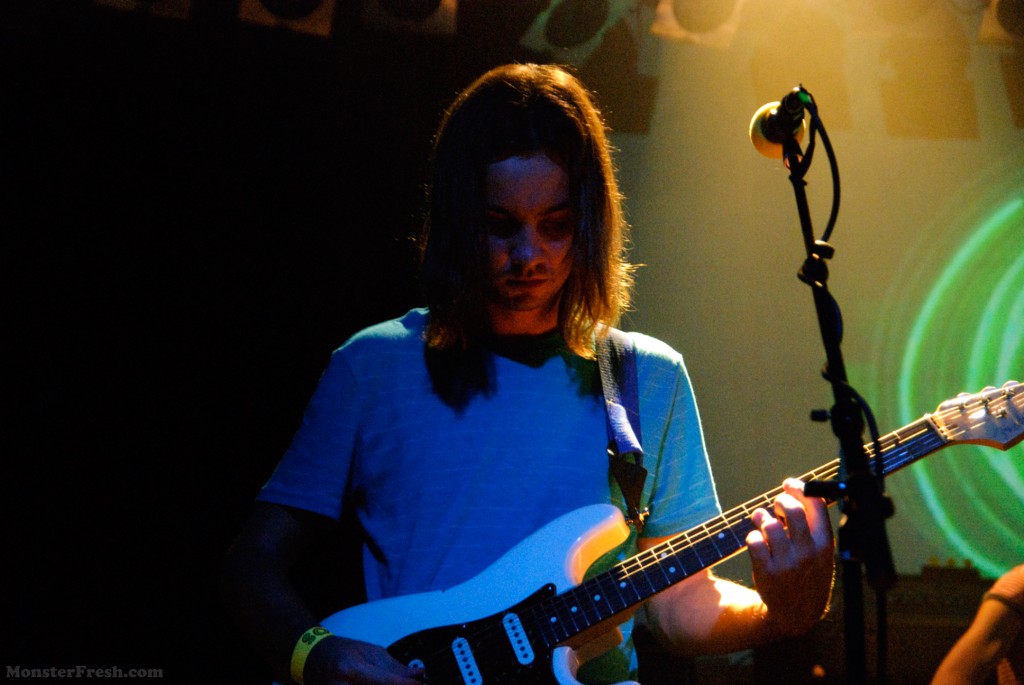“EXPECTATION” – TAME IMPALA Live in Seattle [Feature/Review]
Australia has given birth to longstanding musical influences like Nick Cave and AC/DC, as well as such dated and short-lived commercial outbreaks as Men At Work. As a Westerner, however, it feels as one of two commonalities have regularly presented themselves, over the last two decades, in regards to what has yielded the most prominent promotion from the country to us here overseas. First, there was the young band phenomena of the early Nineties, with teenage acts like SilverChair and Ben Lee‘s first vehicle, Noise Addict, garnering attention after winning Australian talent competitions and being spring-boarded into the international public eye. Then, beginning in the early 2000‘s, Aussie groups like Wolfmother and Jet adopted the heavier and more straight-forward, distorted, and driving sounds of Seventies classic rock, that gained prominence throughout the new millennium. Depending on who you ask or what source you get your information from, the latest exports from “the land down under”, TAME IMPALA, might be described as falling under either one -or even both- of those categories. That is, of course, unless you ask the members of the group themselves. The truth is that TAME IMPALA is, arguably, better than any of the acts that were spawned from either the teen or throwback hypes of the last twenty years and, if their recent performance in Seattle is any indication of their capabilities and versatility as artists, they may even find themselves falling into the category of longstanding musical influences, as well.
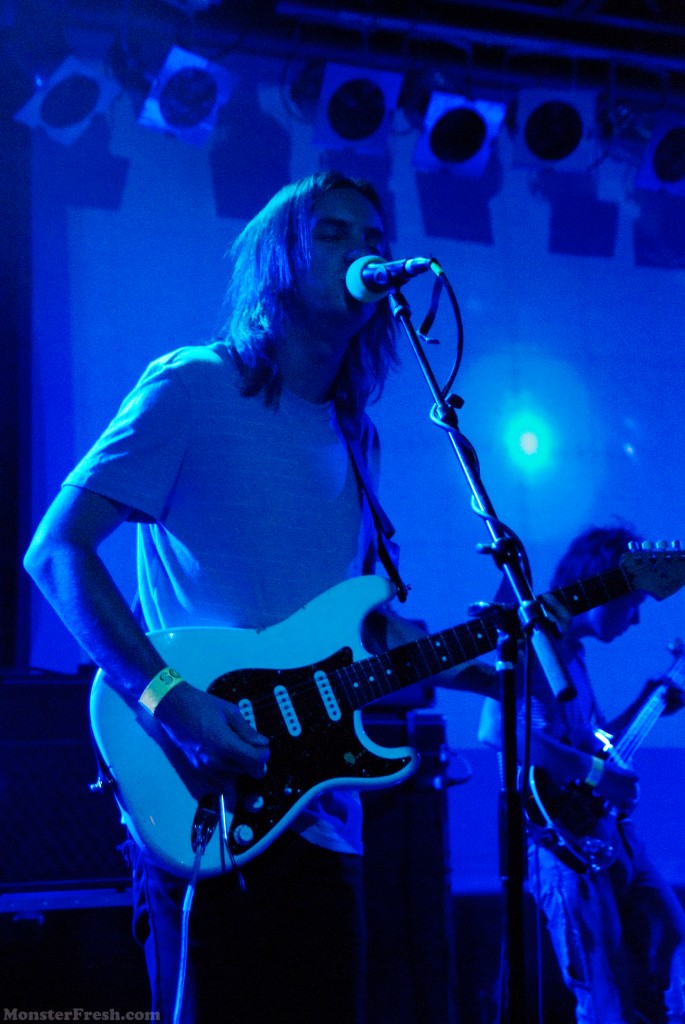 The name “TAME IMPALA” has been slowly gaining traction over the last few years, but a lot of the information available for them is often conflicting. It’s been stated that the group first garnered recognition through their Myspace account and that they are extremely young musicians who were, subsequently, caught in the middle of a bidding war. Other information claims that the group was started back in 1999 by frontman, Kevin Parker and current guitarist/synth-player, Dom Simper, who were only 13 at the time; making them approximately 24 or 25, now (not quite as young as is often implied). I’ve also read that the original name of the group was the DEE DEE DUMS, under which “they” both placed 2nd at AmpFest and 3rd in the state final of The Next Big Thing in 2005. Don’t forget the information about how Parker is an obsessive control freak that manned all of the instruments and recorded all of the “group’s” critically-acclaimed self-titled debut EP all by himself, or even the simple fact that the album was self-titled, at all (it is often misguidedly referred to as “Antares, Mira, Sun” due to the labeled drawing of an astrological diagram as the cover art). The truth is that the DEE DEE DUMS were some form of pseudo-swing/jazz duo that featured Parker on drums and a guy by the name of Luke Epstein on guitar, until Epstein left and Parker switched positions to allow for Sam Devenport to take over on drums. The current lineup doesn’t feature either Epstein or Devenport and, with Simper never even being listed as a member of the DEE DEE DUMS, it hardly makes sense to claim that the duo were even an incarnation of the same group or that TAME IMPALA, in the typical sense of a “group” with Parker and Simper, was formed a full 12 years ago.
The name “TAME IMPALA” has been slowly gaining traction over the last few years, but a lot of the information available for them is often conflicting. It’s been stated that the group first garnered recognition through their Myspace account and that they are extremely young musicians who were, subsequently, caught in the middle of a bidding war. Other information claims that the group was started back in 1999 by frontman, Kevin Parker and current guitarist/synth-player, Dom Simper, who were only 13 at the time; making them approximately 24 or 25, now (not quite as young as is often implied). I’ve also read that the original name of the group was the DEE DEE DUMS, under which “they” both placed 2nd at AmpFest and 3rd in the state final of The Next Big Thing in 2005. Don’t forget the information about how Parker is an obsessive control freak that manned all of the instruments and recorded all of the “group’s” critically-acclaimed self-titled debut EP all by himself, or even the simple fact that the album was self-titled, at all (it is often misguidedly referred to as “Antares, Mira, Sun” due to the labeled drawing of an astrological diagram as the cover art). The truth is that the DEE DEE DUMS were some form of pseudo-swing/jazz duo that featured Parker on drums and a guy by the name of Luke Epstein on guitar, until Epstein left and Parker switched positions to allow for Sam Devenport to take over on drums. The current lineup doesn’t feature either Epstein or Devenport and, with Simper never even being listed as a member of the DEE DEE DUMS, it hardly makes sense to claim that the duo were even an incarnation of the same group or that TAME IMPALA, in the typical sense of a “group” with Parker and Simper, was formed a full 12 years ago.
 From a marketing standpoint, there is a certain logic in retaining the accolades received from his last project but, by all accounts, TAME IMPALA isn’t even a band in the typical sense. The name, more or less, just represents Parker‘s ongoing solo project and home recordings that he had written and arranged by himself. Simper is a longtime friend whom Parker had worked with independently since they were young and, after meeting drummer Jay “Gumby” Watson, he was added into the folds as a third member around 2007. As the hype increased and the EP was garnering positive reviews, reaching #1 on the Australian Independent Record (A.I.R.) charts, IMPALA began performing live as a trio with Simper on bass. Opening slots for groups like MGMT, The Black Keys, and Yeasayer helped further increased their profile and last year the first TAME IMPALA full-length, INNER SPEAKER was released to even further critical praise. Parker was still running the show but, this time around, Simper and Watson both contributed by making scattered appearances on the recording throughout.
From a marketing standpoint, there is a certain logic in retaining the accolades received from his last project but, by all accounts, TAME IMPALA isn’t even a band in the typical sense. The name, more or less, just represents Parker‘s ongoing solo project and home recordings that he had written and arranged by himself. Simper is a longtime friend whom Parker had worked with independently since they were young and, after meeting drummer Jay “Gumby” Watson, he was added into the folds as a third member around 2007. As the hype increased and the EP was garnering positive reviews, reaching #1 on the Australian Independent Record (A.I.R.) charts, IMPALA began performing live as a trio with Simper on bass. Opening slots for groups like MGMT, The Black Keys, and Yeasayer helped further increased their profile and last year the first TAME IMPALA full-length, INNER SPEAKER was released to even further critical praise. Parker was still running the show but, this time around, Simper and Watson both contributed by making scattered appearances on the recording throughout.
I didn’t really start paying serious attention to the TAME IMPALA hype until I began hearing rave review about their live performance after the last –and the first– time that they played in Seattle. From there, I made time to listen to INNER SPEAKER and, while sources like ALL MUSIC make the claim that “their sound was pure late ’60s, but wasn’t the sound of any specific band from the era,” I don’t entirely agree with that assessment. The album immediately sounded like the current-day Swedish psych-outfit, DUNGEN, to me; only it was coupled with the vocal delivery from the more psychedelic offerings in The BEATLES catalog. I’m sure that most reviewers are easily comparing Parker‘s processed vocals to that of John Lennon‘s, but the first song that sprung to mind for me was the McCartney-penned, “Paperback Writer“. The Lennon comparison is unavoidable. The DUNGEN comparison is equally as apt, yet much more avoidable, only because they are far less recognizable (The Beatles have sold over 1.6 billion records). Somewhat loosening his grip on the reins, Parker agreed to hand the mixing duties over to the one person that he felt would truly be able to reinforce his vision: Mercury Rev bassist/neo-psych super producer, Dave Fridman (Flaming Lips, MGMT, Mercury Rev, BMSR, Mogwai, Sparklehorse, etc.). This combination of elements worked to create a surprisingly cohesive sound on Innerspeaker that is expansive and airy, but with melodic elements and moments of heavy driving distortion. It was an impressive debut and one that prompted me to want to experience them live. However, the live version of the band that I was about to see is considered –at least, by it’s members– to be a very different entity than the recording “band” altogether.

TAME IMPALA
Neumos
Seattle, Wa
April 22, 2011
After YUCK left the stage (see review here) and we waited for the headliners to come out, I looked around at the all-ages crowd. The opener’s were a full decade younger than me and their audience, unquestionably, surpassed that gap. I was up towards the front of the crowd and, although there was a solid turnout for the SOLD OUT show, it wasn’t that tightly packed. As I reached over to touch the belly of my pregnant lady, who was standing off to the side, I felt a girl try to work her shoulder around the front of me to block my view. That wasn’t gonna happen, so I worked my arm back around, both preventing access and making sure to expose my camera and pass/wristband in the process. That shit actually works, because there’s a trigger in most people’s brains that is activated, where all of that ridiculous brainwashing with ideas of “celebrity” and “connections” and “authority” and “passes” and “importance”, still exist. “What are you taking pictures for?” she asked interestedly. I was pretty cold, perhaps more than necessary. “So that I can see the show later. So that I can look at images and remember what it looked like.” “No, I mean who are you taking pictures for?” Great, now I’m talking to my “new friend” the young girl at the show, while my pregnant girlfriend stands off to the side watching and, most likely, burning holes through the back of my head. Somehow the topic of the “all ages” crowd came up immediately and the girl proceeded to mention how “weird” it was for her to not be drinking at Neumos (you can’t drink on the All Ages floor) because she is old enough to drink and how she is “usually” drinking there and… basically, she can drink! She’s old enough… she likes drinking at shows! I got it. I’m sure that’s true, but she only looked barely old enough to legally drink at all and, if it was really even a topic that mattered to her, I’m sure that was exactly the case. I thought about how lucky she was that she wasn’t talking to a date-rapey cat with a flask in his pocket and a willingness to exaggerate their position in “journalism.” I usually find it a lot more rewarding to simply work the angle of simulating that creepy vibe, both as a potential warning and as a source of momentary amusement for myself. Instead, I simply cut the topic short by saying, “I don’t really drink that much anymore, especially since she’s pregnant now” and I pointed to Kim. The conversation began to die out at that point and Kevin Parker walked out onto the stage.
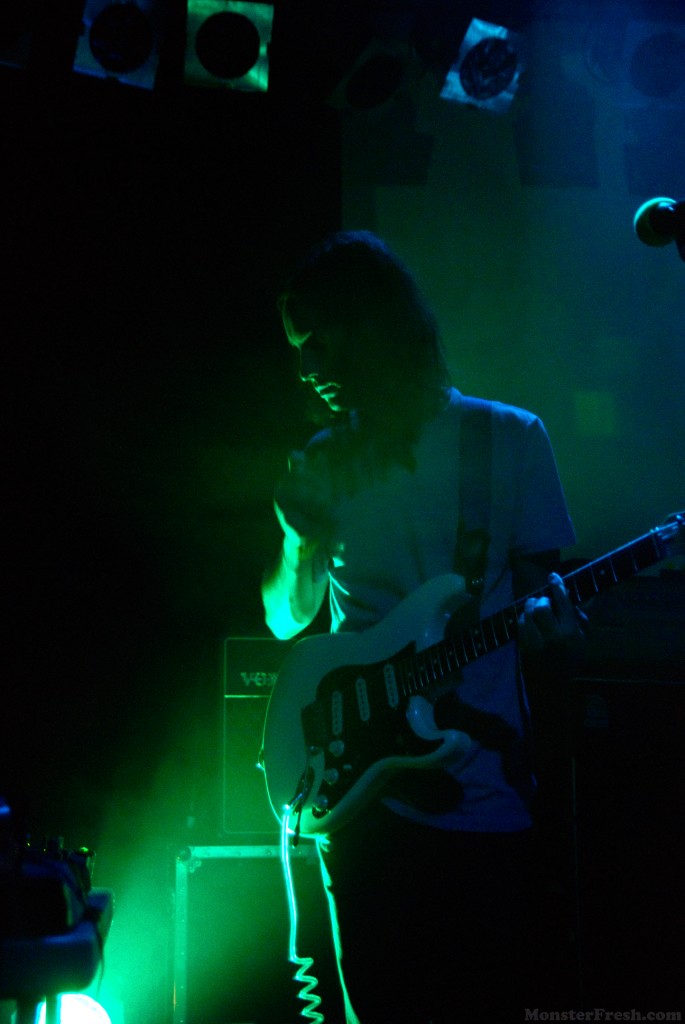 Parker‘s appearance didn’t mark the kick-off of their set; he entered alone, taking a hands on approach and checking the entire stage setup personally. From his own guitar and pedals to the drum kit, he went one by one checking the sound, levels, and their responsiveness to a projector and screen set up in the back of the stage. It wasn’t an elaborate stage show, but a simple projection that would vary from a little glowing green dot to vibrating rings to chaotic squiggles, depending on the the volume and shifts in audio. The frontman sat at the drums, cracking the snare and looking behind him as the dot stretched and morphed into a shaky, slanted oval. The program was little more than a simpler version of the the visuals that come with a Windows Media Player. He left the stage and returned with the rest of the members. The band had expanded from a trio into a 4-piece.
Parker‘s appearance didn’t mark the kick-off of their set; he entered alone, taking a hands on approach and checking the entire stage setup personally. From his own guitar and pedals to the drum kit, he went one by one checking the sound, levels, and their responsiveness to a projector and screen set up in the back of the stage. It wasn’t an elaborate stage show, but a simple projection that would vary from a little glowing green dot to vibrating rings to chaotic squiggles, depending on the the volume and shifts in audio. The frontman sat at the drums, cracking the snare and looking behind him as the dot stretched and morphed into a shaky, slanted oval. The program was little more than a simpler version of the the visuals that come with a Windows Media Player. He left the stage and returned with the rest of the members. The band had expanded from a trio into a 4-piece.
Kevin stood shoeless behind a selection of pedals on the left side of the stage. The lanky, “Gumby” Watson sat at his kit in the back; also shoeless. Between them was the waif, Nick “Paisley Adams” Allbrook, taking over the bass duties for Dominic Simper, who was positioned on the far right, holding a guitar with a synthesizer behind him.
Once everyone got into position, they eased into the song “Why Won’t You Make Up Your Mind“. Even on the album, that track has a full minute of instrumentation before any lyrics kick in, so it was a solid choice to pull the set slowly off of the ground. Now that the they were soaring lightly through a cloudy troposphere of psychedelia, they followed it up with the same song that follows chronologically on Innerspeaker, “Solitude is Bliss.” It begins as a more straight ahead start/stop rock tune, but about two-thirds of the way through, the leash is dropped to allow it to take off into more adventurous experimentation, before stopping altogether and re-entering with a dreamy psych-jazz ending.
Tame Impala may technically be the project of one guy, but the recordings feature some deceivingly intricate interweaving of sound. I appreciate complexities in music from YES and King Crimson style Prog-Rock to Miles and Ornette Coleman freak-jazz, insane Venetian Snares and Squarepusher IDM/Drill n Bass, and Zappa‘s schizophrenically structured compositions, but the complexities of Parker‘s work are assembled somewhat differently. While a lot of elaborately structured pieces expose their cards with such elements as obvious switches in time signature and through exploring a labyrinth of channels, Tame Impala songs have pieces that overlap and meld into each other, bleeding into unified sonic waves, that build and recede like tides and transition as if they were crashing out onto the shore. There’s a life to the Tame Impala recordings that becomes even more impressive when you consider that the psyched-out jam sections are, for the most part, simply Parker jamming out with himself, one singular channel at a time. For the live show, my interests revolved more around if the group would be able to adhere the sound collages from the albums together so effortlessly. In the same way that Parker has managed to create recordings that make him sound as if he were multiple contributors, I wanted to see if the other 3 could synchronize enough with him to unify into that trademark deep-water audio beast and allow it to swim like it does on the albums. When they kicked into Innerspeaker‘s lead-off track “It’s Not Meant to Be” next, that question was answered successfully.
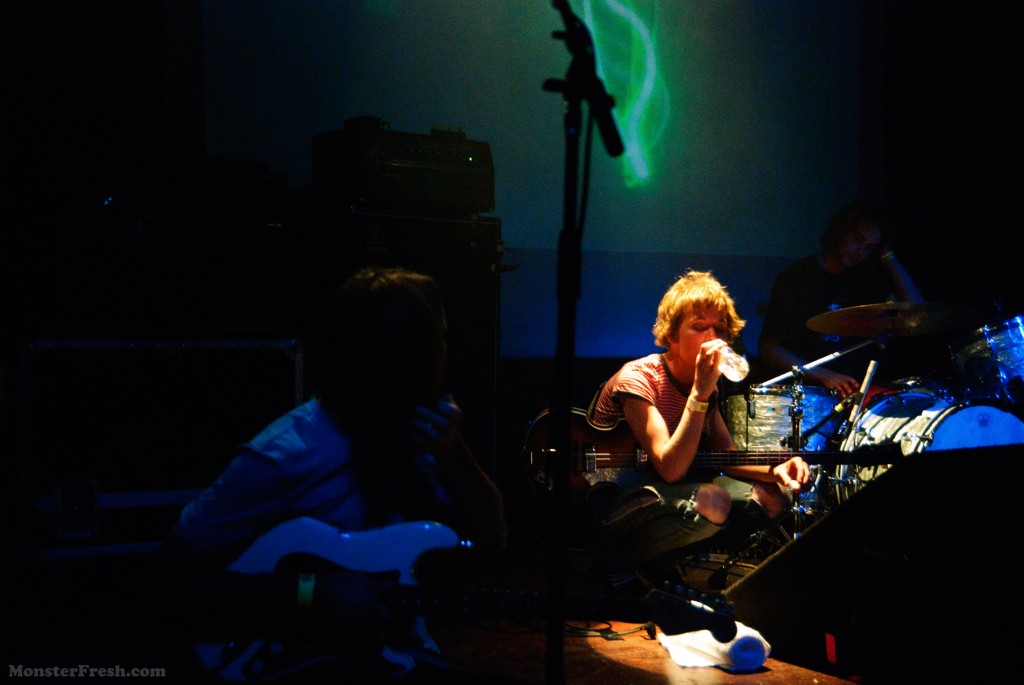
Unlike such masterminds as Frank Zappa, who would meticulously instruct his backing band like an orchestra conductor, there is nothing in Tame Impala‘s live show that reflects any real direction and control from Parker over the other members. This feeds right into their statements about Tame Impala only being a band in the live sense, while the recorded versions stem from nothing anywhere close to a bunch of guys jamming out together in a room. When they are on stage together in their live incarnation, they ride that line of being a very tight band and being completely free and exploratory individual musicians. It felt like a “band” and the members were all very present; no one was phoning it in. The aptly titled “Alter Ego” is a steadily advancing number that really accentuated that fact, allowing the rhythm section to truly showcase their abilities. Sitting behind his kit in his baggy T-shirt and shaggy mop, Watson had a relaxed but fluidly agile attack on the drums, as he aggressively smashed the shit out of the heads, while looking like a 15 year old SoCal skateboarder. Albrook‘s Hofner bass did little to distance the group from the BEATLES comparisons, but his ability to slide the low-end around like playing Q-Bert on a Nordic Track that’s resting on shifting tectonic plates, wasn’t only noticeable, but impressive as well.
Both this track and the followup of their hit, “Expectation” incorporated synth sounds, before the music stopped and the stage went almost entirely dark. There wasn’t much light at the front of the stage to begin with, but now the only light seemed to come from the projection in the back. Parker squatted down and began tweaking sound to interact with and bring focus to the screen. They then segued it into a 6-minute version of “Desire Be, Desire Go“, the one song that appears on both the EP and the Full-Length. At this point, I was trying to film the song with one hand, while trying to snap photos with my other.
[youtube width=”600″ height=”371″]http://www.youtube.com/watch?v=tQmU9buHffo[/youtube]
“Jeremy’s Storm” came next and is a track that begins with a very DUNGEN-esque folk-style guitar intro that builds slowly, adding piece by piece and fattening the sound. There are plenty of soaring moments and gentle free-falls, as well as dark distorted ascensions up a jagged thunder-stricken crag. The instrumental also showcases a good deal of electronic contributions from both Parker and Simper. It was about this time that Parker broke it to the audience that they would not be doing an encore that night, because they feel that encore’s are “lame“. So, after tearing through “Lucidity” and “Runaway Houses City Clouds” they finished the set off with two songs from the self-titled EP. Beginning with “Skeleton Tiger” they effortless jammed into the track “Half Full Glass of Wine” and it was definitely one of the finest moments of the night. Being less familiar with the EP, I wasn’t as aware of when the songs switched up, but that’s probably the greatest result that their efforts could have brought. With swirling mosaics of sound, there was even a part where everything seemed to freeze in mid-air. The music actually stopped and, although the halt was issued abruptly, it felt more as if the audio was momentarily floating like a tai-chi orb, rather than being cut instantly. When the sound re-entered, it was almost as if the silence had been sucked back out of the room in a reverse vacuum. It was as if the guys were giving us a sneak preview of some tricks that they had been working on and their inevitable directional growth for the future. That ending 2-song block was full of free-for-all improvisation with Watson taking full advantage of the open drum solo in “Half Full“. After that, it was over. If some people were still expecting an encore, it was pretty clear that it wasn’t gonna go down.
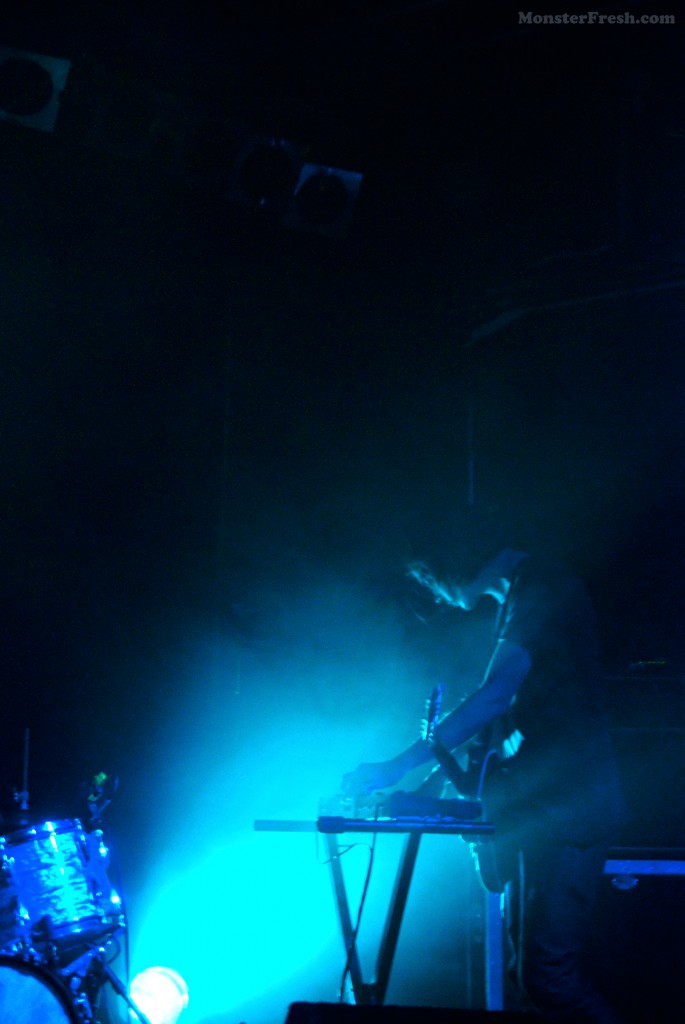 Unlike my feelings about the openers, YUCK, I feel that Parker has managed to actually find and exhibit his own unique voice through Tame Impala, despite any influences or similarities his sound might bear with any of his predecessors. There is a focus on using older, more analog equipment in his work, but everything comes through as honest and his own sound isn’t completely drowned out by the nostalgia. Everything feels natural and nothing seems forced. Whereas the kids from YUCK were fully dressed in throwback gear and emulating various groups that existed just prior to and/or just after their births, Tame Impala doesn’t seem overly concerned with either appearance or with distinct imitation. They’d rather shake the comparisons than to embrace them. They’d rather create music, than become a tribute vessel. Admittedly, these kids look incredibly young, but it’s a factor that actually works in their favor. At this point, all 4 members have already been involved in serious musical endeavors for years. Not only does this add to their technical abilities, but it’s also a testament to the fact that the music and musical exploration is their primary focus. One of the most impressive things that I noticed during the show was when Parker would maintain and control his seamless introduction and transition of effects by tweaking and turning the pedal knobs with his toes. Not only are the bare feet more of a necessity than a gimmick, but the numerous effects that he’s operating with them are being incorporated tastefully to build on the overall sound, more than to create a gimmicky moment of focused noise that overshadows the rest of the compositions.
Unlike my feelings about the openers, YUCK, I feel that Parker has managed to actually find and exhibit his own unique voice through Tame Impala, despite any influences or similarities his sound might bear with any of his predecessors. There is a focus on using older, more analog equipment in his work, but everything comes through as honest and his own sound isn’t completely drowned out by the nostalgia. Everything feels natural and nothing seems forced. Whereas the kids from YUCK were fully dressed in throwback gear and emulating various groups that existed just prior to and/or just after their births, Tame Impala doesn’t seem overly concerned with either appearance or with distinct imitation. They’d rather shake the comparisons than to embrace them. They’d rather create music, than become a tribute vessel. Admittedly, these kids look incredibly young, but it’s a factor that actually works in their favor. At this point, all 4 members have already been involved in serious musical endeavors for years. Not only does this add to their technical abilities, but it’s also a testament to the fact that the music and musical exploration is their primary focus. One of the most impressive things that I noticed during the show was when Parker would maintain and control his seamless introduction and transition of effects by tweaking and turning the pedal knobs with his toes. Not only are the bare feet more of a necessity than a gimmick, but the numerous effects that he’s operating with them are being incorporated tastefully to build on the overall sound, more than to create a gimmicky moment of focused noise that overshadows the rest of the compositions.
Tame Impala might be a solid enough name for the recorded efforts of Kevin Parker, with it’s restrained beacon-like focus mixed with wild frenzied and scattered sound. Then again, maybe it’s a terrible name all around. Through the various interviews that I’ve seen or read, however, I’ve come to realize that an Impala isn’t a very common term in Australia. Every interviewer seems to ask the guys the same question, “What’s an Impala?” and the answer usually comes with the added information that everyone is even less familiar with the Chevy than they are the animal. Whatever the case, the live incarnation of the band is much more comparable to that of an electric dolphin, diving and weaving with aerial maneuvers and oceanic depth. There’s a reason for the tight mesh that the band seems to have formed between each other; this isn’t “their” only group. Technically, Kevin was just grabbing up members to help him support a tour of songs that he had crafted by himself, but he didn’t just grab them from anywhere. What I’m saying is that, they aren’t simply studio musicians. In fact, Nick and Kevin have another fairly intense psychedelic group called Mink Mussel Creek that features Parker on drums, while Allbrook plays guitar and sings. Furthermore, Parker has become the latest permanent drummer -and impressively so- for a fellow Perth, Australia group called Pond, which again features Nick Allbrook on vocals, but with Jay Watson on guitar. These guys are much more of a collective than anything and, as any of them will openly admit to you, Tame Impala is just a collection of Kevin‘s songs and just happens to be the project that got picked up. This is another similarity that Tame Impala shares with DUNGEN, who originated and is primarily controlled as a project of multi-instrumentalist/frontman Gustav Ejstes. To unnecessarily compare the Australians to their Swedish counterparts, I would have to say that they don’t quite have the versatility of DUNGEN quite yet, but their live show is still solid and, with that final display of Skeleton/Half Full, they definitely have the chops to get somewhere as equally impressive in time. At such an early point in their careers, the members of Tame Impala are already incredibly dangerous and, with their technical and production abilities, they should have complete control over which direction they choose to take these talents.

As stated earlier, I immediately liked the Innerspeaker album when I first heard it, but I did ask myself why these kids are getting so much hype right now when they immediately draw such obvious comparisons to DUNGEN, a band that seems to have been all but overlooked in recent years. Then I remembered that the answer to that question -beyond the fact that they sing in Swedish– deals with Gustav‘s disinterest and lack of motivation for feeding into the predetermined system laid out for him by the industry. After the popularity of his album, Ta De Lungt flung them into the international limelight in 2004, followed by extensive touring, he was spent. When they returned with the follow up Tio Bitar (3 years later) he didn’t support it with the “proper” tours or continue to even care about or deal with press and media attention. Instead, he disappeared for a while on his parents estate. He dealt with his own personal life and when the album 4 was released in 2008, it further eschewed much of the garage rock/psych vibe from his previous efforts and began to expand on his penchant for piano-focused jazz infused compositions. Ejstes lost many with his new direction and has still yet to regain that hype that was built around that break out release. I wasn’t one of them. I still love all of the DUNGEN releases and appreciate the constant expansion and risks he takes with their sound. Plus, they are one of the most solid and consistent live acts that I’ve ever seen. I believe that Tame Impala could have a similar growth. I don’t see any signs of these guys slowing down or of Parker ceasing to create music. It seems to be ingrained in who they are as people. I can, however, see him returning with a Tame Impala album that takes a new direction that might not meet the expectations that people have set for him. Remember, they gained much of their hype while opening for MGMT, a band who both instantly sprung to fame with their Fridmann-produced debut, only to lose fans and critics alike with their impressively ambitious sophomore effort. I guess that my point is, although I feel completely sure that Parker is focused on the music, I’m not so sure that he’s overly focused on the industry. As far as this collective of Perth musicians are concerned, on the other hand, I’m interested to see what comes out of it, regardless of whatever name is plastered across the front of the work that they produce. They seem to be enjoying themselves and worrying about the one thing that they should be focused on, creating music. Parker has spoken openly about the fact that he has already put a lot of work into crafting the sequel to Innerspeaker and that he intends to release it later this year. I’m curious to see what kind of new directions in sound that it will yield but, even if these Australians never release another commercially successful effort again, the idea of them ending their run with a hit track entitled, “Expectation” might be worth the irony.

